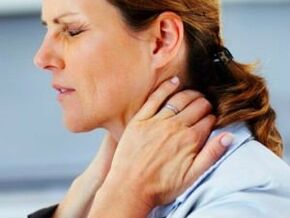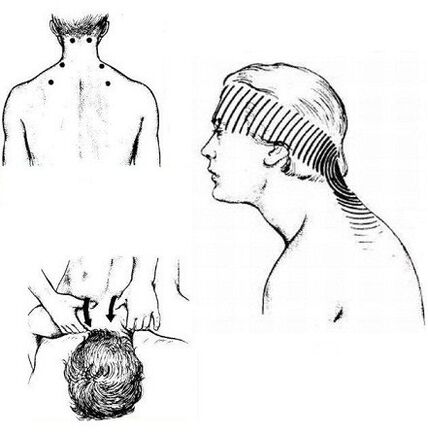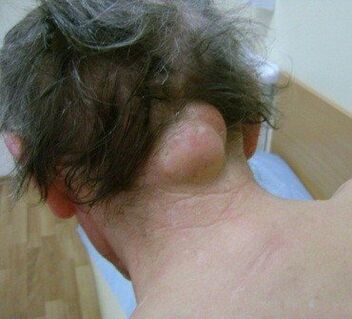
The human neck, like other animals, is an unusual body part, somewhat fragile, but strong.
The cervical spine, along with all the muscles and ligaments, supports and moves the faucet, absorbs shocks while walking, protects the brain from concussions, protects the blood vessels that feed it, and even protects the spinal cord.
It can be said that almost everyone has experienced neck pain in their lifetime. Neck pain can affect men and women at any age.
When the neck hurts, the reason can vary. Some of them can resolve on their own in a matter of days, and some can cause chronic aches and pains.
Why does pain occur?
The most common reason why your neck hurts is poor body posture. With the back bent, the head stops occupying a position just above the body and moves forward. In this position, the muscles and ligaments of the neck experience increased tension. The development of sore throat and neck is facilitated by prolonged work without changing position, sleeping on a soft bed or high pillow, prolonged static load.
Other causes of neck pain are injuries from falling from the head, in a road accident, or while playing sports. With sharp acceleration and then braking, the cervical spine makes a whiplash motion. As a result, ligaments and muscles can stretch, displacement or compression fractures occur on the cervical vertebrae, and the formation of intervertebral hernias.
Neck pain can occur as a secondary manifestation of other diseases. For example, with a heart attack, when a heart attack causes severe pain, it radiates along the nerve plexus to the upper limbs, chest, neck. Neck pain with a heart attack is only part of a complex of symptoms - shortness of breath, sweating, nausea, vomiting. If your neck, jaw ache and other signs of a heart attack are observed, you should immediately call an ambulance.
Neck pain is also used as a diagnostic sign of meningitis. With this disease, the neck muscles become hypertonic, that is, they become stiff. As you tilt your head to your chest, your back neck aches badly.
The spine in the neck area is sore with rheumatoid arthritis, osteoporosis, fibromyalgia, spondylosis and osteoarthritis, hernia or protrusion, with compression of the nerve root or spinal cord with infectious edema, abscess, tumor or benign neoplasm.
Special case
Degenerative diseases
Osteochondrosis, or, in other words, a dystrophic disorder of the intervertebral disc, leads to the fact that a person’s neck is always sore. This is usually a mild pain, which is often accompanied by numbness and pain in the shoulders and head.
The collar zone affected by osteochondrosis can lead to the development of cerebral artery syndrome. With a decrease in intervertebral distance in this area, compression damage to the vertebral arteries occurs at the transverse process openings of the cervical vertebrae. Pressure on the vessels causes a decrease in blood flow to the brain with the onset of dizziness, decreased vision and hearing. In contrast, mechanical stimulation of the arteries with pressure from the vertebrae causes reflex spasm, which manifests itself as a throbbing pain in the head.
Treatment
If the neck is constantly sore with a background of osteochondrosis, then therapy is initiated with the elimination of the pain syndrome. The second mandatory treatment direction is to stop the degenerative process in the cervical vertebrae.
Pain relief can be achieved by using the following groups of medications:
- non -steroidal anti -inflammatory drugs - directly block the cascade of intermediaries that signal pain;
- muscle relaxation - relieves muscle spasms, which arise reflexively due to severe pain;
- sedatives - they calm and inhibit the nervous system and the transmission of pain impulses, including (valerian, antidepressants, sleeping pills);
- vasodilators - help relieve vertebral artery syndrome and associated pain.
To eliminate the cause of neck pain in osteochondrosis, chondroprotective drugs are prescribed that prevent the destruction of cartilage and vertebrae, as well as multivitamin mineral complexes.
Pain management also consists of physical therapy, physiotherapy, massage, traction, reflex therapy and tape. During exacerbations, to relieve pain, patients are advised to wear a special collar that protects the neck from excessive movement.
Muscle pain

Pain in the neck can occur when the muscles in the neck become inflamed called myositis.
Such pain should be distinguished from neuritis (inflammation of the nerve trunk with sensory disturbances) and pain caused by osteochondrosis.
Myositis occurs suddenly, after exposure to predisposing factors-hypothermia, vibration, prolonged excess, especially with repetitive movements of the same type.
Cervical myositis is characterized by acute pain that occurs when inflamed muscles contract. The severity of the sharp pain causes difficulty performing certain movements.
Typically, the long neck muscles on the anterolateral surface or the sternocleidomastoid muscles are sore, which, with bilateral contractions, pull the head backwards, and with unilateral contractions, they twist it.
The deep muscles that surround the spine are also often inflamed and move the entire neck and back.
While detecting muscles, increased tone and dense knot areas were observed. Violations of microcirculation and local trophism result in the gradual replacement of myocytes with connective tissue. As a result, the neck muscles weaken, their symmetry is broken on the sides of the spine, torticollis may appear, and it is difficult for the patient to keep his head straight.
Treatment
Treatment begins by reducing the tension in the neck. This is followed by a series of physiotherapeutic procedures - heating with UHF, electrophoresis with drugs, heating with paraffin, bandages with ozokerite, diathermy, massage, acupuncture. Such a procedure restores blood circulation to the neck muscles. Of these medications, B vitamin injections, anti-inflammatory and analgesic drugs, ointments and scrubs are prescribed.
Alternative treatments recommend using cabbage leaves or burdock as a compress to relieve pain, prepare an ointment from willow buds pounded in butter, make a scrub from a mixture of turpentine with apple cider vinegar and egg yolk. Also, the neck is rubbed with lava oil, and then wrapped. The main guarantee of success of any treatment is to take care of the sore neck until the muscles are fully recovered. Then you should start to put it back "on duty" with special gymnastics and massage.
Radicular syndrome
Severe neck pain, which spreads to the muscles of the head, shoulder girdle, upper limbs, can occur when the roots of the spinal cord are pinched during prolapse, protrusion or herniated discs.
With this disease, the nucleus in the disc protrudes into the spinal canal or its lateral horn. Hernias and their symptoms usually appear on one side. When pressure is exerted on the nerve roots of the spine, a sharp burning pain appears in the muscles that are turned on (cervical lumbago). The patient feels numbness in the lower jaw, the area around the ears, the back of the head, the shoulder blades, the arms. Dizziness appears, sharp neck pain when changing position from horizontal to vertical. The gradual protrusion of the disc nucleus causes trauma to the surrounding tissue, its inflammation, and edema. This poses a prerequisite for inflammation of the nerve endings with the development of radiculitis, the movement of the neck and upper limbs is gradually limited. Prolonged spinal cord violations lead to paresis or paralysis of the limbs.
Therapy
What to do if the neck hurts with a hernia? At home, with pain syndrome, painkillers, non-steroidal anti-inflammatory drugs, hormone medications, muscle relaxants are taken to relieve cramps.
In the hospital, severe pain in the neck is relieved with the help of "restrictions" - the introduction of anesthetic substances on the sides of the spine.
Swelling and inflammation are treated with steroids that can be injected directly into the hernia. Muscle pain is relieved by taking a muscle relaxer.
Also, to prevent the development of hernias, I use drugs that strengthen cartilage tissue - chondroprotectors.
In many cases, therapeutic exercises and traction of the cervical spine with protrusion or slight protrusion help. The increase in intervertebral space helps "pull" the intervertebral disc and relieves pressure on the nerves.
In a true hernia with rupture of the fibrous annulus and prolapse of the nucleus into the spinal canal, surgery is required. There are several ways to get rid of neck pain through surgery:
- anterior cervical dysectomy - removal of an extra piece of disc that presses on the spinal cord;
- replacement of damaged discs with artificial joints, which protect the cervical spine from further destruction;
- microendoscopic dysectomy using a posterior approach and removal of a small area of the hernia through endoscopy;
- posterior cervical dysectomy through an incision in the back of the neck. The operating channel is specially enlarged so that the pinch does not develop in the future.
Neoplasm

If there is persistent pain in the neck, one may suspect the appearance of external education in this department.
Benign or malignant tumors in the neck can arise in the vertebral body, blood vessels, epithelium, connective, nerve, adipose or glandular tissue.
Benign tumors (lipomas, fibromas, neuromas, osteomas, hemangiomas) often have the correct shape and are clearly limited, rarely causing pain. The discomfort is primarily related to the compression of the surrounding tissue by the tumor. Malignant tumors (osteosarcoma, myeloma, cancer of the lymph nodes or thyroid gland) have no boundaries, they give many metastases to nearby tissues. The damaging effects of their organs cause a painful sensation, a deterioration of the general condition. The front of the neck can get sick with cancer of the larynx, throat, mouth organs, thyroid gland. The patient has difficulty swallowing, there is swelling in the neck and face, changes in voice. If cervical flight is painful with a bone tumor, then this condition also often leads to damage to the spinal cord and nerve roots on the sides of the spine with the development of paralysis.
Treatment
Treatment of pain in neoplasms aims primarily to eliminate the cause - reduce or eliminate swelling. For this purpose, chemotherapy and radiation therapy, hardening of the ducts that supply the tumor, and surgery to remove the pathological formation are used.
Pain relief depends on the severity of the pain:
- weak painkillers;
- pain relievers of moderate severity;
- with increasing pain, they turned to weak opium;
- with severe pain, analgesia is only possible with the help of opiate medications. To improve pain analgesia in the neck with neoplasms, antipsychotics, anticonvulsants, and corticosteroids are used.
Notes! Neck pain can occur for a variety of reasons. In order not to escape from a serious illness, it is first necessary to consult a doctor to consult about the occurrence of pain and the exact determination of its source.























